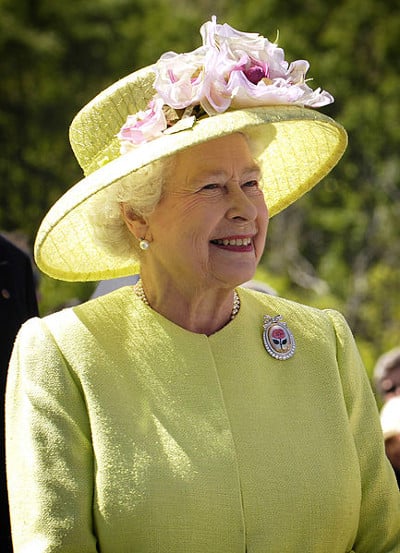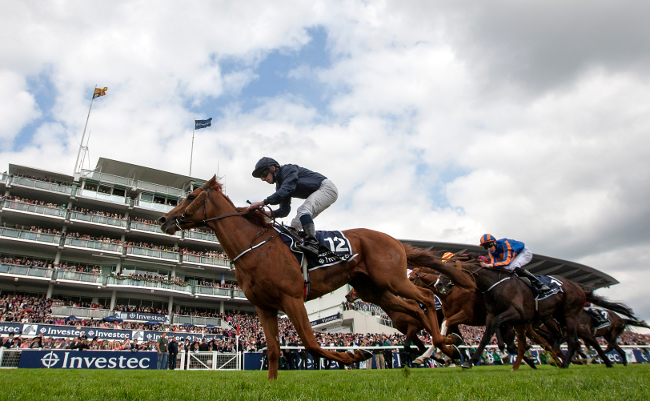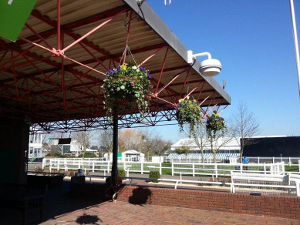Original URL: https://www.theregister.com/2014/05/20/horse_racing_and_it/
Big data? Internet of things? Sport of Kings inches into high tech
Britain got used to a woman leader quicker than horse racing picked up on IT
Posted in Software, 20th May 2014 08:28 GMT
In Clare Balding’s autobiography My Animals and Other Family she relates the story of her father, a renowned horse trainer, telling an owner after Mrs Thatcher’s 1979 election victory that “it’s going to take a while to get used to a woman running the country”. The horse owner was the queen of the United Kingdom, Elizabeth II.

The Queen is known to enjoy a flutter.
Photo by NASA
Balding’s book also acts as an introduction to how training yards used to work. “Some trainers now use a computer program to suggest every horse that is qualified for each race, but Dad didn’t have that luxury – nor would he have used it,” she writes. “He preferred to plan individually for every horse in the yard and write, with his all-colour Biro, the names of the horses he wanted to be entered next to the relevant races.” This is in 1990, when millions of homes and businesses had computers.
Horseracing trots on as IT gallops away
A quarter of a century has not seen the sport of kings and queens gallop ahead in adopting IT, at least not in training. A racing secretary at a leading National Hunt training yard who wished to remain anonymous told The Reg that apart from administration and a website, her organisation makes little use of technology beyond the scales used to weigh horses once a week and the blood samples, which are tested elsewhere. It makes declarations and books entries with racing administrator Weatherby’s online and it has its own website, but some trainers don’t even go this far.
Compared with the high-tech world of Formula One racing, “I think this would be the opposite end of the scale,” she says.
There are good reasons for this. “A lot of training horses is to do with horsemanship, having a feel the animals. They are athletes that don’t talk, at the end of the day,” says the racing secretary.
When she takes horses out for training rides, “my boss says to me: 'how does he feel'? You can have all the equipment in the world, but you need that human interaction.”
With the flat season* well underway and the racing calendar now just over midway between the power trio of Cheltenham, the Grand National and Royal Ascot, a considerable amount is currently being invested in such "feelings."
Technology enters the yard
Those seeking to put a bit more tech into training agree. “Fundamentally you’re dealing with flesh and blood,” says Tim Jones, European managing director of Fine EquinITy. “Any technological information is only going to supplement your instincts.”
Fine EquinITy, founded by racehorse owners Keith Hanson and Steve Catchpole, has developed a monitor that aims to do just that. In a similar fashion to body-worn monitors for human runners, it combines tracking of a horse’s heart-rate with a GPS location tracker, allowing energy use to be calculated.
Hanson and Catchpole used the software division of their chemical firm Fine Industries to develop software that can analyse whether a horse is suffering from illness or fatigue. (They have since sold Fine Industries – but kept Fine EquinITy.)
The monitors, which are attached to a horse’s girth (the strap which keeps the saddle in place), store the data ready for download by USB. “It’s designed to be as simple for the trainer and staff to use a physically possible,” says Jones. From this data, the system generates reports, including split times for each furlong or eighth of a mile (about 201m): 15 to 18 seconds is an easy canter, while 10.5 or 11 seconds is top speed for exercise. “The whole idea is to give a trainer a snapshot for the piece of work,” says Jones.
There are further ways to use IT in training, according to Dr Meriel Moore-Colyer, dean of the school of equine management and science at the Royal Agricultural University in Cirencester. One is to use high-speed cameras to video horses and riders wearing markers for gait analysis – a technique used with humans to help treat multiple sclerosis.
In horse training, this can check for an equal space between front and hind legs – an unequal measure indicates an injury – and the horse’s potential for jumping.

Software analysis of camera footage can be used to analyse performance and spot injuries
On the latter, Dr Moore-Colyer says a horse can perform better than its conformation (its measurements) suggests if it jumps well, such as by folding its front legs, positioning its hind ones well and jumping close to the fence.
Software analysis of camera footage can reveal potential high-fliers, as well as spotting changes that indicate injuries. She says that such techniques have mainly been used as a research tool so far, but are available to trainers through referral centres, and are “increasing in number and cheapness”.
Technology is even making inroads into such traditional industries as saddle-making. Some fitters use a set of pressure sensors between the horse and saddle for test rides. “It tells you where you need to stuff the saddle, or rebalance things if something is not right,” says Dr Moore-Colyer. “A lot of shoulder lameness is caused by saddles.”
Comparing such work to fitting a bespoke suit, she says this also helps horses and riders perform to the best of their ability.
The actual racing of horses is a bit further around the track in using technology, although still far behind other sports: “It’s gone through a long phase of doing nothing,” says Nic Christodoulou, a former outside broadcast producer of sporting events for the BBC.
Wi-Fi in the running
Horse racing in Britain adopted photo finishes for the flat racing season of 1947 after an investigation by the Jockey Club. The Race Finish Recording Company, set up to provide the finish-line cameras, is now known as RaceTech, and its cameras are now digital, generating an image based on single-pixel vertical lines of the racing post over a few seconds. This allows a comparison of runners at the exact point at which they complete the race, available to stewards seconds after the race is over.
The firm also helps protect the purity of the turf. Courses now have at least five video cameras recording races, “viewed by stewards to ensure there is no, shall we say, funny business,” says Christodoulou, now director of engineering and technical operations for RaceTech.
When possible, these provide a head-on view, as it is usually easier to spot forbidden behaviour such as a jockey cutting across another’s line – although telephoto foreshortening can make horses look closer than they are. For this reason, side cameras are also useful. “Stewards are calling for more and more,” says Christodoulou.

Spot the wireless access point, at
Cheltenham Racecourse. Photo by: The Jockey Club
But the company’s newest system moves away from cameras, tracking horses’ every hoof through a local positioning system. This works in a similar way to GPS, but uses a transponder on each horse and receivers around the course rather than signals from satellites.
It places horses in three dimensions – running uphill, unsurprisingly, affects how fast a horse runs. RaceTech has tested the system at Kempton Park racecourse with 16 receivers, plus two extra finish-line cameras around the course to cross-check the positioning system’s accuracy. “It’s been pretty spot on to a few-thousandths of a second,” says Christodoulou.
He said he sees numerous uses for the system. It can already provide sectional times for each horse for every furlong and a live on-the-track ranking, as seen in other sports such as Formula One. It could be used to provide more material for stewards and enable new types of bets – fastest horse at start, "winner" of a given furlong – and interactive computer games.
“You could put yourself there in the race, in a virtual world,” says Christodoulou, conjuring images of a Grand National ride for everyone, “but it relies on the data.” That data could also be used to let gamers play at being fantasy trainers – but could also be used by real trainers, jockeys and owners to review a horse’s performance.
David Dommett, group IT director for the Jockey Club – which runs 15 racecourses, including Kempton Park, Cheltenham and Aintree – wants to use such systems to make racing a better day out. “When you’re on a course watching a horse race, you can’t necessarily see all the action,” he says, and a tracking system could help spectators follow a race by overlaying data on camera images. He also sees other potential for tagged horses, such as letting people view data through their smartphone when they point it at their fancied runner.
But this requires good mobile access to data – and networks around racecourses tend to get hopelessly overloaded on big race days. “It gets to 11 o’clock on the day of the Grand National, and you can’t communicate with anybody,” says Dommett.

Tracking of horses during races with RaceTech could mean extra services for punters
So for this year’s Cheltenham Festival, the Jockey Club established a permanent 2Gbit wireless network, with 189 access points, 13,500 metres of cabling and 7,650 metres of fibre, supplied by Xirrus and managed by Aircom. The idea was to allow tens of thousands of spectators to get online. Altogether 35,000 did just that, making a total of 886,000 visits to partners’ websites, with the platform recording 5.5 million events.
“One of the challenges in a racecourse is that consumers don’t stand in one place,” Dommett points out, saying that perhaps 20,000 moved from one part of the course to another while watching a race. He carried out his own test: “I managed to walk from one end of the grandstand to the other streaming BBC iPlayer, and there were 15,000 people at the time.”
The Jockey Club is now looking at how to set up similar networks at other courses.
This could allow racecourse spectators to bet through their smartphones, which Dommett sees as a welcome additional option. But he thinks many will want to stick with traditional methods: “There’s a historical and cultural thing about going to the rail with your five quid,” he says.
Racing is finding ways to make better use of technology, but it’s mainly about people and – as jockeys love to say in post-race interviews with Clare Balding and her colleagues – the horse. ®
* As the name suggests, horses racing on the flats rather than with jumps. The season runs in the summer, from "the day the Lincoln Handicap is programmed until the afternoon the November Handicap is programmed" – usually from late March until early November.